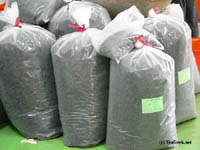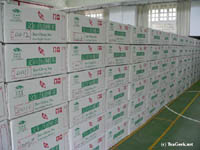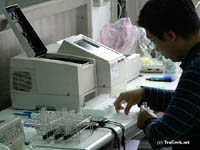I think the pictures say it all.
Perhaps it’s a good day to drink tea, but not to be tea.
When we talk about a particular tea–Darjeeling, for example, or Bai Hao Wulong–it’s something of an error to think of it as “a” tea. Really, all of these names, from Dragonwell to Silver Needles to Puer to Assam, are all categories of tea. To be truly speaking of a single pure (i.e. non-blended) tea, you need to talk about a particular batch, picked on the same day, and following it straight through processing at a single facility without getting mixed in with any other batch. Even from the same farm and the same plants, and the same processing style, each picking (even if two pickings happen from the same patch of plants on the same day) will be different. A tea picked early in the morning will often produce a lower-quality tea than leaves picked just before noon, so a tea farmer sometimes produces two different teas in a single day.
But with each farm potentially making potentially two different teas each day the weather’s good, how do you differentiate? How do you refer to one versus another? Well, that’s where it gets even more confusing. As with all things in the tea world, the right answer appears to be “it depends.”
Generally, a tea can be referred to by a number of different features of its production history. It can be referred to by geography, whether a city (Darjeeling, Puer) or a state/province/region (Assam, Yunnan, Keemun/Qimen), or a local feature (Dragon Well, Alishan [Mt. A-Li]). Other teas are referred to primarily by what varietal of the tea plant they are made from: Tie Guan Yin (Iron GuanYin), Jin Xuan (Golden Lily), Si Ji Chun (Four Season Spring). Still others are named based on their appearance: Bi Luo Chun (Green Spiral Spring), Yin Zhen (Silver Needle). Some just have fanciful names like Oriental Beauty or Old Work Tea. And to make matters worse, some are named after a combination, as in “Wuyi” which is both a mountain range and the name of a varietal, and often implies a certain style of processing. And “Oolong” or “Wulong” (same Chinese characters, different method of rendering into English letters) can refer either to the entire category of semi-oxidized teas or to a specific cultivar of Camellia sinensis var. sinensis or even to the specific semi-oxidized teas made from that cultivar.
Then there are the modifications to this basic name. Some teas are classified by the British system, dividing teas into grade based on how big the leaf pieces are. The bigger the pieces, the higher the grade. These grade divisions are encoded in a string of letters such as BOPF (Broken Orange Pekoe Fannings, otherwise known as “very small pieces”) and FTGFOP (Finest Tippy Golden Flowery Orange Pekoe, or sometimes jokingly translated as “Far Too Good For Ordinary People”). Other teas are graded by how much effort and care has gone into them. Keemun Congou–or “Qimen Gongfu” if you de-Anglicise it–is the basic quick and dirty version, while Keemun Mao Feng has more care taken but still uses somewhat older leaves, and Keemun Hao Ya takes the most effort and uses the most young and delicate leaves. Hao Ya is divided further into “A” and “B” with the former being the cream of the crop. Keemun Hao Ya “A” goes through an extra hand-sorting process that is skipped with “B”.
Then, going from the frying pan into the fire as they say, some teas are named incorrectly. That is to say, there are many teas called “Dong Ding” that are not made actually on Dong Ding mountain. They’re called that because they’re made in the style of teas from that area. Another is Chinese Sencha. Sencha is a distinctly Japanese tea, but for economic and business reasons, some Japanese tea companies are having the tea grown in China but processed like they would have been had it been grown in Japan. Is this really Sencha, or a Chinese green tea made in the Sencha tradition to Japanese specifications?
All of this boils down to an impossibly complicated and confusing mess when it comes to referring to a particular tea. To be really accurate, one could refer to all of the specifics, like “Makaibari Estate, Darjeeling, India, FTGFOP, Black Tea, Pick Date May 2nd, 2008, 10:45am” or “Su family farm, Dong Ding Shan, Nantou County, Taiwan, oxidized for 12 hours at an average of 20 degrees Celsius, rolled mechanically, and roasted three times for 2 hours each at 80, 100, and 110 degrees. Only picking of November 12th 2008, from the lower of the two patches of Wulong varietal.”
But who wants to ask for a cup of that?
However, what might help is if everyone starts asking about these aspects of nomenclature. Ask at your local tea shop if they know whether this wulong was hand picked and processed or machine harvested. Ask your waiter at the restaurant if the Darjeeling is a blend or single estate. Check your online tea sources for varietal of tea plant used.
While the tea industry is nowhere near agreeing on a universal nomenclature to describe each tea one from another, at least by asking the questions to clarify these finer points we can all encourage tea industry professionals to know their stuff. And even if it’s called “Li Shan Wulong” on the jar or package, you may be able to discover information that differentiates this one from the “Li Shan Wulong” from the shop down the street. At least then we as a tea community can start talking about teas with real information and not just the short label of two or three words given to the true complexities of geography, climate, botany, biochemistry, and human artistry that make each and every batch of tea unique.
One of the experiences I had in Taiwan was to visit Pinglin, where a famous tea competition is held at least twice each year–for the Spring and Winter tea seasons. Pinglin is a township in Taipei County, a little more east than south of the city of Taipei in northern Taiwan. On the one hand, it was disappointing because we got there when the weather was awful for tea picking and processing. On the other, we got there on the first day that farmers were bringing in their entries for the Winter competition.
 It was an interesting process to see, with lots of people working very fast. First, the farmer would arrive at the school gymnasium with a large sack of tea weighing about 28 pounds (or just over 12.6 kilos). The sack would be weighed, and a number would be assigned. Forty-two metalic bags and a small plastic zip-close bag would be put into the farmer’s sack. All 43 inserted bags would have already been labeled in advance with the assigned number by the industrious people at the first table. A person further down the table would take some of the tea and put it in the zip-close bag and set it aside.
It was an interesting process to see, with lots of people working very fast. First, the farmer would arrive at the school gymnasium with a large sack of tea weighing about 28 pounds (or just over 12.6 kilos). The sack would be weighed, and a number would be assigned. Forty-two metalic bags and a small plastic zip-close bag would be put into the farmer’s sack. All 43 inserted bags would have already been labeled in advance with the assigned number by the industrious people at the first table. A person further down the table would take some of the tea and put it in the zip-close bag and set it aside.
 Next, the big sack was taken to one of five tables scattered around one side of the gym. Each table was covered in plastic and was attended by six or seven people, mostly women with generally a man supervising or auditing. The 42 metallic bags are taken out and the tea is dumped on the plastic-covered table. Each of the metallic bags holds half a jin of tea. (A jin in Taiwan is 600 grams, which is slightly more than either 21 ounces, or 1.3 pounds. To be confusing, in mainland China, a jin is 500 grams, or about 1.1 pounds.) Most of the people at the table scoop up roughly a half-jin of tea and put it in one of the bags. They are then given to a person with a scale who fine-tunes the weight to exactly 300 grams per bag. The bags then go to yet another person who heat-seals each bag and packs them into two boxes labeled with the appropriate lot number. Ten jin (20 bags) fit in each box, for a total of 20 jin. The other two bags don’t fit into the boxes.
Next, the big sack was taken to one of five tables scattered around one side of the gym. Each table was covered in plastic and was attended by six or seven people, mostly women with generally a man supervising or auditing. The 42 metallic bags are taken out and the tea is dumped on the plastic-covered table. Each of the metallic bags holds half a jin of tea. (A jin in Taiwan is 600 grams, which is slightly more than either 21 ounces, or 1.3 pounds. To be confusing, in mainland China, a jin is 500 grams, or about 1.1 pounds.) Most of the people at the table scoop up roughly a half-jin of tea and put it in one of the bags. They are then given to a person with a scale who fine-tunes the weight to exactly 300 grams per bag. The bags then go to yet another person who heat-seals each bag and packs them into two boxes labeled with the appropriate lot number. Ten jin (20 bags) fit in each box, for a total of 20 jin. The other two bags don’t fit into the boxes.
 Ah, but there’s a method to this madness. The two boxes are then stacked in the half of the gym where nobody is working. (Over the course of the 5 days when entries can be delivered, that half of the gym will be more or less filled with tea. Next time you’re in a gym, think of half of it filled with tea leaves and consider how much space the ounce or two you typically buy at your local tea shop takes up. It’s a staggering amount of tea.)  The two forlorn bags that didn’t fit into the neatly stacked boxes are eventually taken to the building where the judging happens. This last “extra” jin is what gets brewed for the judges. Any tea left from the original farmer’s sack is put back in and given back to him. Even though it’s from the same batch, it cannot legally be called competition tea because it’s not in the special numbered bags.
Ah, but there’s a method to this madness. The two boxes are then stacked in the half of the gym where nobody is working. (Over the course of the 5 days when entries can be delivered, that half of the gym will be more or less filled with tea. Next time you’re in a gym, think of half of it filled with tea leaves and consider how much space the ounce or two you typically buy at your local tea shop takes up. It’s a staggering amount of tea.)  The two forlorn bags that didn’t fit into the neatly stacked boxes are eventually taken to the building where the judging happens. This last “extra” jin is what gets brewed for the judges. Any tea left from the original farmer’s sack is put back in and given back to him. Even though it’s from the same batch, it cannot legally be called competition tea because it’s not in the special numbered bags.
 Meanwhile, that little zip-close baggie of tea that was separated at the beginning of this process is taken to the ground floor of the building where, upstairs, the judging will occur. Below, however, are a couple of people hard at work brewing samples of tea. They, however, don’t get to drink it. Instead, they put the tea in fancy scientific equipment to test the samples for pesticides and agricultural chemicals (which was something that took a while for me to figure out–I didn’t know the Chinese term for “pesticides and agricultural chemicals” and the closest our friend Mr. Tsai knew in English was “medicine.” Thank goodness for Pleco!)
Meanwhile, that little zip-close baggie of tea that was separated at the beginning of this process is taken to the ground floor of the building where, upstairs, the judging will occur. Below, however, are a couple of people hard at work brewing samples of tea. They, however, don’t get to drink it. Instead, they put the tea in fancy scientific equipment to test the samples for pesticides and agricultural chemicals (which was something that took a while for me to figure out–I didn’t know the Chinese term for “pesticides and agricultural chemicals” and the closest our friend Mr. Tsai knew in English was “medicine.” Thank goodness for Pleco!)
Since we were there on the 12th of November and the actual judging didn’t start until, I think, the 20th. If my understanding of the explanation wasn’t too far off and my memory holds, the three days of judging were November 20th through the 22nd, and the winners were announced on the 24th. But Mr. Tsai and Mr. Chen did treat us to a tasting of three submissions (but I don’t know their numbers so I can’t tell if any of them won or not).
My friend and tea teacher, Shiuwen Tai, now has available the First Place, Second Place, an Honorable Mention, and one of her supplying farmer’s personal favorites (“Farmer’s Choice” she calls it). I have some tea made by the Second Place farmer, but it wasn’t the same batch that won. Check out mine at the Tea Geek Store, and Shiuwen’s at FloatingLeaves.com. Get a little of each and taste them side-by-side!